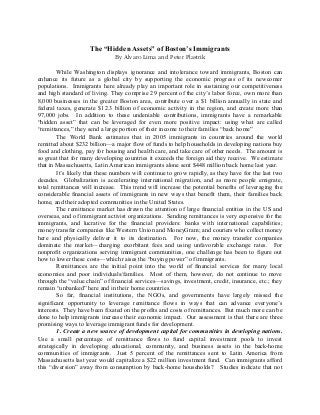
Remittances are Hidden Assets
- 1. The “Hidden Assets” of Boston’s Immigrants By Alvaro Lima and Peter Plastrik While Washington displays ignorance and intolerance toward immigrants, Boston can enhance its future as a global city by supporting the economic progress of its newcomer populations. Immigrants here already play an important role in sustaining our competitiveness and high standard of living. They comprise 29 percent of the city’s labor force, own more than 8,000 businesses in the greater Boston area, contribute over a $1 billion annually in state and federal taxes, generate $12.3 billion of economic activity in the region, and create more than 97,000 jobs. In addition to these undeniable contributions, immigrants have a remarkable “hidden asset” that can be leveraged for even more positive impact: using what are called “remittances,” they send a large portion of their income to their families “back home” The World Bank estimates that in 2005 immigrants in countries around the world remitted about $232 billion—a major flow of funds to help households in developing nations buy food and clothing, pay for housing and health care, and take care of other needs. The amount is so great that for many developing countries it exceeds the foreign aid they receive. We estimate that in Massachusetts, Latin American immigrants alone sent $448 million back home last year. It’s likely that these numbers will continue to grow rapidly, as they have for the last two decades. Globalization is accelerating international migration, and as more people emigrate, total remittances will increase. This trend will increase the potential benefits of leveraging the considerable financial assets of immigrants in new ways that benefit them, their families back home, and their adopted communities in the United States. The remittance market has drawn the attention of large financial entities in the US and overseas, and of immigrant activist organizations. Sending remittances is very expensive for the immigrants, and lucrative for the financial providers: banks with international capabilities; money transfer companies like Western Union and MoneyGram; and couriers who collect money here and physically deliver it to its destination. For now, the money transfer companies dominate the market—charging exorbitant fees and using unfavorable exchange rates. For nonprofit organizations serving immigrant communities, one challenge has been to figure out how to lower these costs—which raises the “buying power” of immigrants. Remittances are the initial point into the world of financial services for many local economies and poor individuals/families. Most of them, however, do not continue to move through the “value chain” of financial services—savings, investment, credit, insurance, etc.; they remain “unbanked” here and in their home countries. So far, financial institutions, the NGOs, and governments have largely missed the significant opportunity to leverage remittance flows in ways that can advance everyone’s interests. They have been fixated on the profits and costs of remittances. But much more can be done to help immigrants increase their economic impact. Our assessment is that there are three promising ways to leverage immigrant funds for development. 1. Create a new source of development capital for communities in developing nations. Use a small percentage of remittance flows to fund capital investment pools to invest strategically in developing educational, community, and business assets in the back-home communities of immigrants. Just 5 percent of the remittances sent to Latin America from Massachusetts last year would capitalize a $22 million investment fund. Can immigrants afford this “diversion” away from consumption by back-home households? Studies indicate that not
- 2. all remittances are currently spent on “survival consumption”; small portions may be used for longer-term investments such as education. In addition, if transaction fees for remittances were lowered, the reduction in cost could be used to build the capital funds we are describing. Not all of these remittance pools would have to be return-seeking funds; some could be foundations with financial endowments built out of remittances. 2. Invest in building the wealth-creating capacities of immigrants in the US. Use a portion of remittance flows to invest in the capacity of immigrants in the US to create even more wealth than they currently do, supporting business development, increased education, and other economic development strategies. 3. Create a “bundle” of services to immigrants in the US, based on remittance services. The number of remittance-sending immigrants in the US is a huge, untapped market for other product and services. Banks and other organizations are already trying to sell this market on some other financial services. But immigrant populations have other interests—such as information and entertainment from their home countries. Helping immigrants to enter the conventional financial world is an important step towards building the individual, household, and community assets. Providing other services through this “channel to the market” can further enrich their lives and create market opportunities right here. A city like Boston can take advantage of these ways to leverage the remittance market— by getting the business sector, the nonprofit community, and the government itself to focus on the opportunities. Doing this could help its many newcomers fulfill their own role as financial providers for their global families, develop their own assets, and to contribute to their new city. That’s what a truly global city would do.
